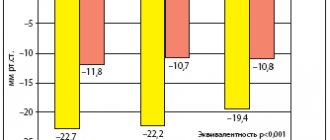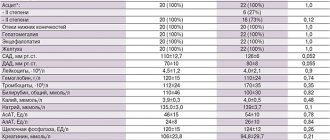The Recommendations retain the approach to determining the overall cardiovascular risk using SCORE, taking into account the fact that in patients with hypertension, this risk increases significantly in the presence of target organ damage associated with hypertension (especially left ventricular hypertrophy, CKD). Among the factors influencing the cardiovascular prognosis in patients with hypertension, the level of uric acid was added (more precisely, returned), early menopause, psychosocial and economic factors, and a resting heart rate of 80 beats/min or more were added. Asymptomatic target organ damage associated with hypertension includes moderate CKD with a glomerular filtration rate (GFR) <60 ml/min/1.73 m2, and severe CKD with a GFR <30 ml/min/1.73 m2 (calculated using the formula CKD-EPI), as well as severe retinopathy with hemorrhages or exudates, swelling of the optic nerve nipple. Asymptomatic kidney damage is also determined by the presence of microalbuminuria or an increased albumin/creatinine ratio in the urine. The list of established diseases of the cardiovascular system is supplemented by the presence of atherosclerotic plaques in imaging studies and atrial fibrillation.
An approach has been introduced to classify hypertension according to the stages of the disease (hypertension), taking into account the level of blood pressure, the presence of risk factors affecting the prognosis, target organ damage associated with hypertension, and comorbid conditions (Table 3).
The classification covers the range of blood pressure from high normal to grade 3 hypertension.
There are 3 stages of hypertension (hypertension). The stage of hypertension does not depend on the level of blood pressure, but is determined by the presence and severity of target organ damage.
Stage 1 (uncomplicated) - There may be other risk factors, but there is no end-organ damage. At this stage, patients with grade 3 hypertension are classified as high risk, regardless of the number of risk factors, as well as patients with grade 2 hypertension with 3 or more risk factors. The moderate-high risk category includes patients with stage 2 hypertension and 1-2 risk factors, as well as stage 1 hypertension with 3 or more risk factors. The moderate risk category includes patients with grade 1 hypertension and 1-2 risk factors, grade 2 hypertension without risk factors. Patients with high normal blood pressure and 3 or more risk factors correspond to low-moderate risk. The remaining patients were classified as low risk.
Stage 2 (asymptomatic) implies the presence of asymptomatic target organ damage associated with hypertension; CKD stage 3; DM without target organ damage and assumes the absence of symptomatic cardiovascular diseases. The state of target organs corresponding to stage 2, with high normal blood pressure, places the patient in the moderate-high risk group, with increased blood pressure of 1-2 degrees - in the high-risk category, 3 degrees - in the high-very high risk category.
Stage 3 (complicated) is determined by the presence of symptomatic cardiovascular diseases, CKD stage 4 or higher, and diabetes with target organ damage. This stage, regardless of blood pressure level, places the patient in the very high risk category.
Assessment of organ damage is recommended not only to determine risk, but also for monitoring during treatment. Changes in electro- and echocardiographic signs of left ventricular hypertrophy and GFR during treatment have a high prognostic value; moderate - dynamics of albuminuria and ankle-brachial index. Changes in the thickness of the intima-medial layer of the carotid arteries have no prognostic significance. There is insufficient data to conclude on the prognostic value of pulse wave velocity dynamics. There is no data on the significance of the dynamics of signs of left ventricular hypertrophy according to magnetic resonance imaging.
The role of statins has been emphasized to reduce cardiovascular risk, including greater risk reduction while achieving BP control. Antiplatelet therapy is indicated for secondary prevention and is not recommended for primary prevention in patients without cardiovascular disease.
Positions of b-blockers in the new European guidelines for the treatment of arterial hypertension
One of the most important sections of the treatment of patients with hypertension is the choice of antihypertensive therapy. The new recommendations on hypertension retained the previously formulated approach regarding the possibility of prescribing any of 5 classes of antihypertensive drugs (diuretics, including thiazide, chlorthalidone and indapamide; β-blockers; calcium antagonists; angiotensin-converting enzyme inhibitors; angiotensin receptor blockers) to lower blood pressure, taking into account contraindications for there are no indications for the preferential use of any of them [4]. The fact is that the largest existing meta-analyses show the absence of clinically significant differences between different classes of drugs [5, 6]. Thus, β-blockers retained their position among other classes of antihypertensive drugs, despite the appearance of a number of publications with critical remarks and the withdrawal of this class of drugs from the group of priorities for the treatment of hypertension, as, for example, happened in the UK. The reasons why, in contrast to some other recommendations, β-blockers remain an option for antihypertensive treatment have been discussed in detail previously in the 2009 revision [4]. Recognizing the low quality of the evidence, a Cochrane meta-analysis (largely replicating a 2006 meta-analysis by the same authors) [8, 9] noted that β-blockers may be inferior to some (but not all) other classes of drugs on a number of endpoints. They appear to be inferior to calcium antagonists (but not diuretics and ACE inhibitors) in terms of overall mortality and incidence of cardiovascular events, calcium antagonists and ACE inhibitors in terms of effect on the incidence of strokes, and equivalent to calcium antagonists, ACE inhibitors and diuretics in terms of reducing the risk of developing coronary artery disease. On the other hand, another large meta-analysis showed that initiation of therapy with beta-blockers was as effective as other major classes of antihypertensive agents in preventing coronary events and was highly effective in preventing cardiovascular events in patients with recent myocardial infarction and in heart failure [5]. A meta-analysis performed by a group of antihypertensive therapy researchers also noted that the incidence of cardiovascular endpoints with β-blockers and/or diuretics or their combination is the same as with other classes of drugs [6]. The somewhat lower effectiveness of β-blockers in preventing stroke [5] was associated with their lower ability to reduce central SBP and pulse pressure [10]. However, reduced preventive efficacy against stroke is also inherent in ACE inhibitors [5], although the latter, according to available publications, control central blood pressure better than β-blockers [10]. Apparently, β-blockers also have more side effects, although the differences from other drugs in this regard, established during double-blind studies, were less pronounced, and somewhat less effective than RAAS inhibitors and calcium antagonists in terms of slowing or delaying organ damage. targets such as left ventricular hypertrophy, carotid intima-media thickness, aortic stiffness, and small artery remodeling [11]. In addition, β-blockers promote weight gain [12] and, especially in combination with diuretics, the development of diabetes mellitus in predisposed patients [13]. Perhaps the latter phenomenon was exaggerated due to the fact that the analysis of all studies included only patients without diabetes or with a glycemic level <7.0 mmol/l, ignoring the fact that a significant number of patients with an initial diagnosis of diabetes mellitus had this diagnosis in was not confirmed at the end of the study. This clearly diminishes the significance of drug-induced diabetes and casts doubt on the correctness of the disease definition used in the above analysis [14]. Some of the limitations of classical β-blockers are absent in a number of vasodilating β-blockers, such as celiprolol, carvedilol and nebivolol, which are more widely used today, are better at reducing central pulse pressure and aortic stiffness than atenolol or metoprolol [15, 16], and have less effect on sensitivity. to insulin than metoprolol [17, 18]. It should be noted that both carvedilol and nebivolol have proven themselves to a greater extent in clinical studies in heart failure rather than in hypertension [19]. Finally, it was recently described that β-blockers do not increase, but even reduce the risk of exacerbations and mortality in chronic obstructive pulmonary disease [20]. When conducting a treadmill test with exercise in 2318 men (average age 60 years) with hypertension, it turned out that in those receiving β-blocker monotherapy or receiving them as part of combination therapy, blood pressure, heart rate (HR) and the product of heart rate x blood pressure at maximum and submaximal load were significantly lower than in patients receiving any other antihypertensive drugs or their combination, regardless of race [21]. These data need to be confirmed and their impact on clinical outcomes has not yet been studied. Treatment with beta-blockers may be appropriate to avoid excessive increases in blood pressure during normal daily activities or during intense exercise in hypertensive patients who exhibit an exaggerated blood pressure response during exercise testing. Another point is that it would be useful to conduct clinical trials to study long-term outcomes in such patients when treated with β-blockers and other classes of antihypertensive drugs. Blood pressure indicators against the background of physical activity are a predictor of cardiac risk and can be useful in the management of patients with a hypertension phenotype that is resistant to drug therapy and with orthostatic hypertension. It is important to remember the potential danger of increased heart rate in cardiovascular patients and the existence of a direct relationship between heart rate and mortality in the population: with a heart rate greater than 70 beats/min. Mortality rates are starting to rise. This circumstance should also be taken into account when prescribing drugs. The advantages of b-blockers in such cases are especially obvious. Doubts about the advisability of using β-blockers in patients with uncomplicated hypertension, which have arisen recently, associated with the results of the LIFE and ASCOT studies, as well as meta-analyses, relate mainly to atenolol and should not automatically be transferred to other representatives of this class of drugs, especially having additional properties [4]. Mechanism of antihypertensive action Despite long-term study, the mechanism of antihypertensive action of β-blockers is not entirely clear [21]. It is assumed that the decrease in blood pressure is mediated through various mechanisms: under their influence, cardiac output decreases, heart rate and renin levels decrease. β-blockers, which have intrinsic sympathomimetic activity, do not affect heart rate and do not reduce cardiac output, but cause a decrease in peripheral resistance and blood pressure, especially with long-term use. Blockade of peripheral β2-adrenergic receptors in the case of non-selective β-blockers may lead to an increase in peripheral vascular resistance. However, after a few weeks of treatment, vascular tone returns to its original level or even decreases. Reducing peripheral vascular resistance is important in maintaining the hypotensive effect of β-blockers. β-blockers with additional properties, such as vasodilating effects, reduce peripheral vascular resistance. Indications for the use of β-blockers According to the new recommendations, it is advisable to prescribe β-blockers to control blood pressure in patients who have previously had a myocardial infarction, patients with angina pectoris, CHF, aortic aneurysm, persistent or paroxysmal atrial fibrillation, in pregnant women, as well as any other antihypertensive drug - after a stroke. β-blockers as part of combination therapy Recently, much attention has been paid to the issues of combination therapy in patients with hypertension. This is due to the fact that monotherapy does not provide adequate control of blood pressure in all patients with hypertension, and accordingly there is a need to prescribe two, and in some cases more, antihypertensive drugs. Combination therapy has the following advantages: mutual potentiation of the action of the drugs included in the combination allows them to be prescribed in lower doses, which reduces the likelihood of undesirable effects compared to full-dose monotherapy; target blood pressure values are achieved faster, which is especially important for high-risk patients; allows you to achieve more stable blood pressure control throughout the day; the use of fixed combinations of antihypertensive drugs simplifies the treatment regimen, which improves treatment adherence. The new guidelines for the treatment of hypertension present a new algorithm for choosing combination antihypertensive therapy (Fig. 1). One of the effective, and in accordance with the Russian recommendations on hypertension, rational combinations are β-blockers in combination with diuretics [1]. Thiazide diuretics have a pronounced antihypertensive effect comparable to other first-line drugs. The effectiveness of their use in lowering blood pressure and reducing cardiovascular mortality has been proven in several controlled randomized studies and confirmed by the results of meta-analyses. The use of low-dose thiazide diuretics (12.5–25 mg hydrochlorotidezide per day) in large randomized clinical trials was not associated with an increase in the number of new cases of diabetes mellitus and an increase in total cholesterol compared with placebo. This combination is indicated as preferred (green), but has a number of limitations (dashed line), mainly associated with a higher risk of developing metabolic disorders. β-blockers and thiazide diuretics have a complementary effect, enhancing the hypotensive effect of each other. β-blockers suppress the activity of the renin-angiotensin system, which may be increased by diuretics. Diuretics, due to their vasodilating and natriuretic effects, prevent the development of undesirable effects of β-blockers. In Russian recommendations on hypertension, rational combinations of antihypertensive drugs include “β-blocker + diuretic” and “dihydropyridine calcium antagonist + β-blocker”; the latter combination, according to some European experts, is possible, but has been studied to a lesser extent [3]. The combination of “β-blocker + dihydropyridine calcium antagonist” is characterized by a potentiation of the hypotensive effect and a decrease in the number of side effects, since β-blockers counteract the possible compensatory activation of the sympathoadrenal system in response to therapy with calcium antagonists, and the latter have a beneficial effect on the lipid spectrum of the blood and have anti-atherosclerotic properties . Due to its antianginal effect, this combination is especially indicated for patients with hypertension in combination with coronary artery disease. The primary indications for prescribing a rational combination of calcium antagonists with β-blockers are ischemic heart disease; atherosclerosis of the carotid and coronary arteries; tachyarrhythmias; isolated systolic hypertension; elderly age; pregnancy. It is possible to use β-blockers in combination with all other antihypertensive drugs (ACE inhibitors, angiotensin receptor blockers, etc.), the antihypertensive effectiveness of these combinations continues to be studied. Contraindications to the use of β-blockers As noted in the new recommendations, β-blockers are absolutely contraindicated in patients with asthma and 2-3 degree atrioventricular block. Relative contraindications to the use of β-blockers: metabolic syndrome, impaired glucose tolerance, chronic obstructive pulmonary disease (β-blockers with a vasodilating effect can be used), in athletes or physically active young people. Conclusion β-blockers remain one of 5 classes of antihypertensive drugs that, in accordance with the new European guidelines, are prescribed for the treatment of hypertension. β-blockers should be prescribed for the treatment of hypertension in patients with coronary artery disease, especially those who have had a myocardial infarction, chronic heart failure, ventricular arrhythmias, supraventricular tachyarrhythmias, diabetes mellitus, pregnant women, and after a stroke. Drugs in this group are good at preventing an increase in blood pressure in people with an excessive hypertensive response to physical activity. β-blockers are recommended together with thiazide diuretics or dihydropyridine calcium channel blockers as part of combination therapy to control blood pressure in patients with high or very high risk hypertension. When choosing a β-blocker, preference should be given to drugs that have an evidence base in the treatment of hypertension, MI, CHF (bisoprolol, metoprolol, carvedilol). Among the listed drugs, the most widely used clinically is currently bisoprolol, which has a pronounced cardioselective effect, minimal side effects, metabolic neutrality and a positive effect on the prognosis of cardiovascular diseases. The optimal bisoprolol preparation presented on the Russian pharmaceutical market is Bidop (). Bidop is presented in doses of 5 and 10 mg and has proven biological and therapeutic equivalence to the original drug.
Literature 1. Russian Medical Society for Arterial Hypertension (RMAS), All-Russian Scientific Society of Cardiologists (VNOK). Diagnosis and treatment of arterial hypertension // Russian recommendations (fourth revision), 2010. 2. Shalnova S.A., Deev A.D., Vikhireva O.V. and others. Prevalence of arterial hypertension in Russia: awareness, treatment, control // Disease prevention and health promotion. 2001. No. 2. P. 3–7. 3. 2013 Guidelines for the Management of Arterial Hypertension: The Task Force for the Management of Arterial Hypertension of the European Society of Hypertension (ESH) and of the European Society of Cardiology (ESC) // J. Hypertens. 2013. Vol. 31(7). P. 1281–1357. 4. Mancia G., De Backer G., Dominiczak A. et al. 2007 Guidelines for the Management of Arterial Hypertension: The Task Force for the Management of Arterial Hypertension of the European Society of Hypertension (ESH) and of the European Society of Cardiology (ESC) // J. Hypertens. 2007. Vol. 25. P. 1105–1187. 5. Law MR, Morris JK, Wald NJ Use of blood pressure lowering drugs in the prevention of cardiovascular disease: meta-analysis of 147 randomized trials in the context of expectations from prospective epidemiological studies // BMJ. 2009. Vol. 338.b1665. 6. Blood Pressure Lowering Treatment Trialists' Collaboration. Effects of different blood pressure-lowering regimens on major cardiovascular events in individuals with and without diabetes mellitus designed: results of prospectively overviews of randomized trials // Arch. Intern. Med. 2005. Vol. 165. P. 1410–1419. 7. Blood Pressure Lowering Treatment Trialists' Collaboration. Effects of different blood-pressure-lowering regimens on major cardiovascular events: results of prospectively-designed overviews of randomized trials // Lancet. 2003. Vol. 362. P. 1527–1535. 8. Wiyonge CS, Bradley HA, Volmink J. et al. Cochrane Database Syst Rev. 2012. Nov. 14.11:CD002003.doi. 9. Bradley HA, Wiyonge CS, Volmink VA et al. How strong is the evidence for the use of beta-blockers as first line therapy for hypertension? // J. Hypertens. 2006. Vol. 24. P. 2131–2141. 10. Williams B., Lacy PS, Thom SM et al. Differential impact of blood pressure-lowering drugs on central aortic pressure and clinical outcomes: principal results of the Conduit Artery Function Evaluation (CAFE) study // Circulation. 2006. Vol. 113. P. 1213–1225. 11. Mancia G., Laurent S., Agabiti-Rosei E. et al. Re-appraisal of European guidelines on hypertension management: a European Society of Hypertension Task Force document // J. Hypertens. 2009. Vol. 27. P. 2121–2158. 12. Sharma AM, Pischon T., Hardt S. et al. Hypothesis: Betaadrenergic receptor blockers and weight gain: A systematic analysis // Hypertension. 2001. Vol. 37. P. 250–254. 13. Elliott WJ, Meyer PM Incident diabetes in clinical trials of antihypertensive drugs: a network meta-analysis // Lancet. 2007. Vol. 369. P. 201–207. 14. Zanchetti A., Hennig M., Baurecht H. et al. Prevalence and incidence of the metabolic syndrome in the European Lacidipine Study on Atherosclerosis (ELSA) and its relation with carotid intima-media thickness // J. Hypertens. 2007. Vol. 25. P. 2463–2470. 15. Dhakam Z., Yasmin, McEniery CM, Burton T. et al. A comparison of atenolol and nebivolol in isolated systolic hypertension // J. Hypertens. 2008. Vol. 26. P. 351–356. 16. Kampus P., Serg M., Kals J. et al. Differential effects of nebivolol and metoprolol on central aortic pressure and left ventricular wall thickness // Hypertens. 2011. Vol. 57. P. 1122–1128. 17. Bakris GL, Fonseca V, Katholi RE et al. Metabolic effects of carvedilol vs metoprolol in patients with type 2 diabetes mellitus and hypertension: a randomized controlled trial // JAMA. 2004. Vol. 292. P. 2227–2236. 18. Celik T., Iyisoy A., Kursaklioglu H. et al. Comparative effects of nebivolol and metoprolol on oxidative stress, insulin resistance, plasma adiponectin and soluble P-selectin levels in hypertensive patients // J. Hypertens. 2006. Vol. 24. P. 591–596. 19. McMurray JJ, Adamopoulos S, Anker SD et al. ESC of acute and chronic heart failure 2012: The Task Force for the Diagnosis and Treatment of Acute and Chronic Heart Failure 2012 of the European Society of Cardiology. Developed in collaboration with the Heart Failure Association (HFA) of the ESC // Eur. Heart J. 2012. Vol. 33. P. 1787–1847. 20. Rutten FH, Zuithoff NP, Halk F. et al. Beta-Blockers may reduce mortality and risk of exacerbations in patients with chronic obstructive pulmonary disease // Arch. Intern. Med. 2010. Vol. 170. P. 880–887. 21. Metelitsa V.I. Handbook of clinical pharmacology of cardiovascular drugs. 3rd ed. M.: MIA, 2005. pp. 435–451.









